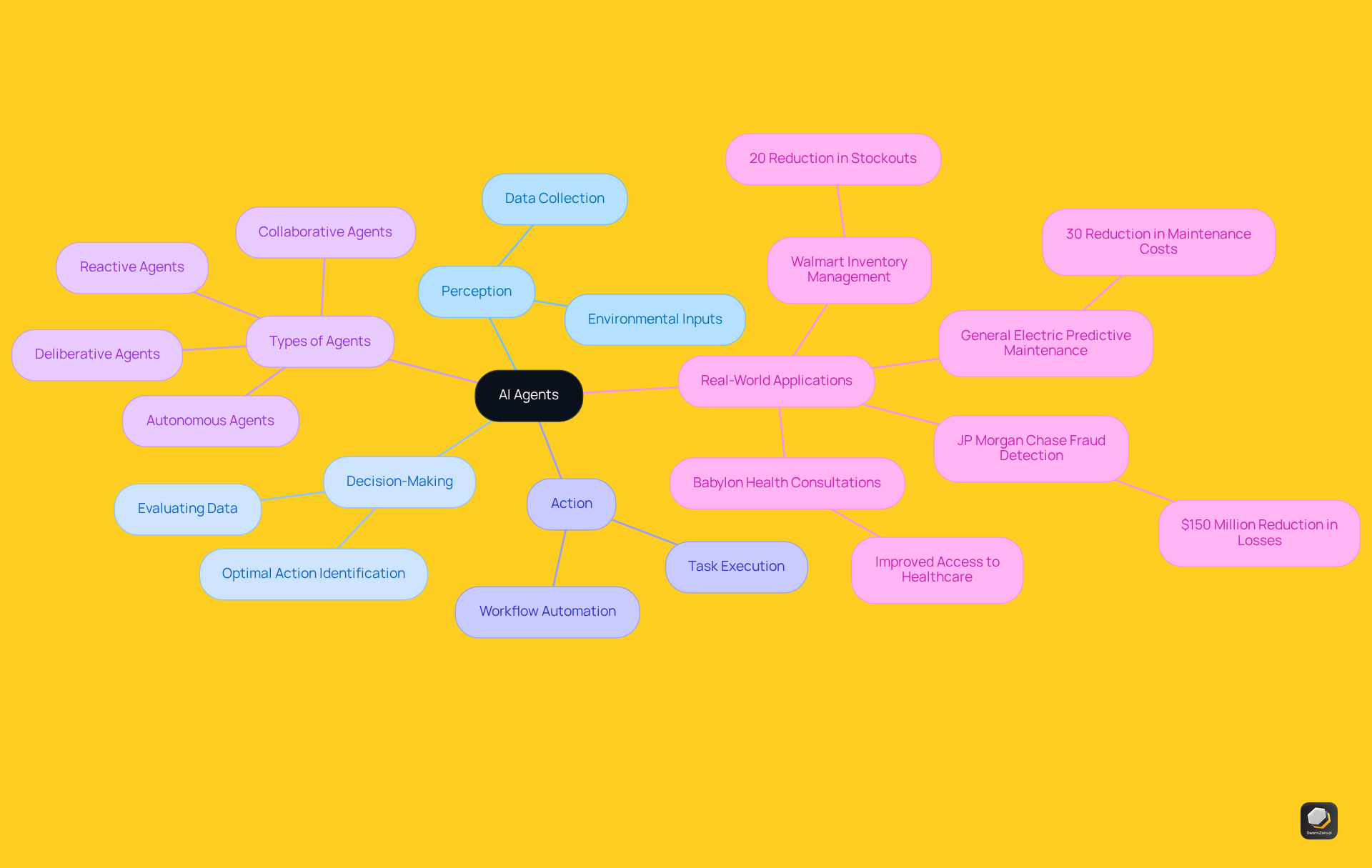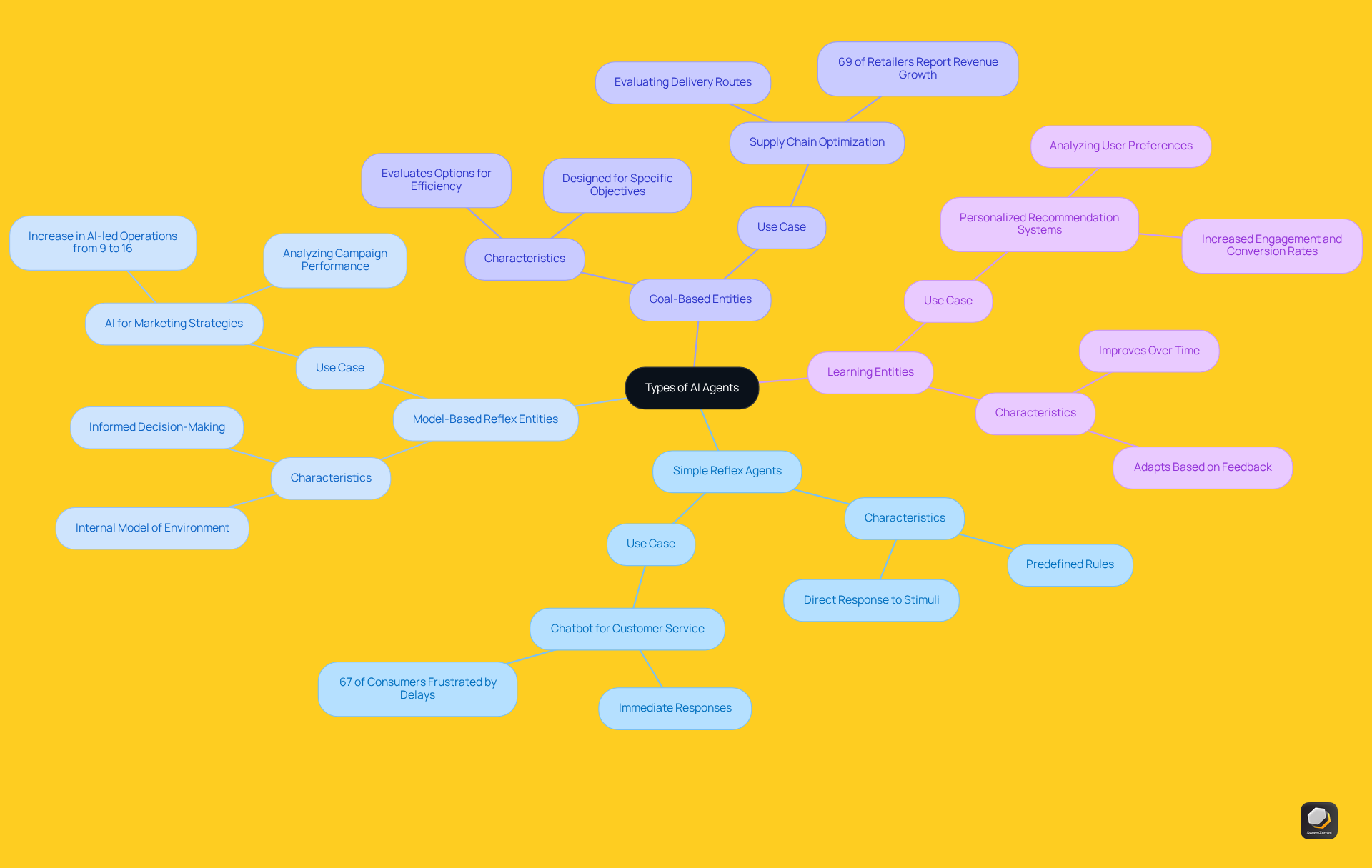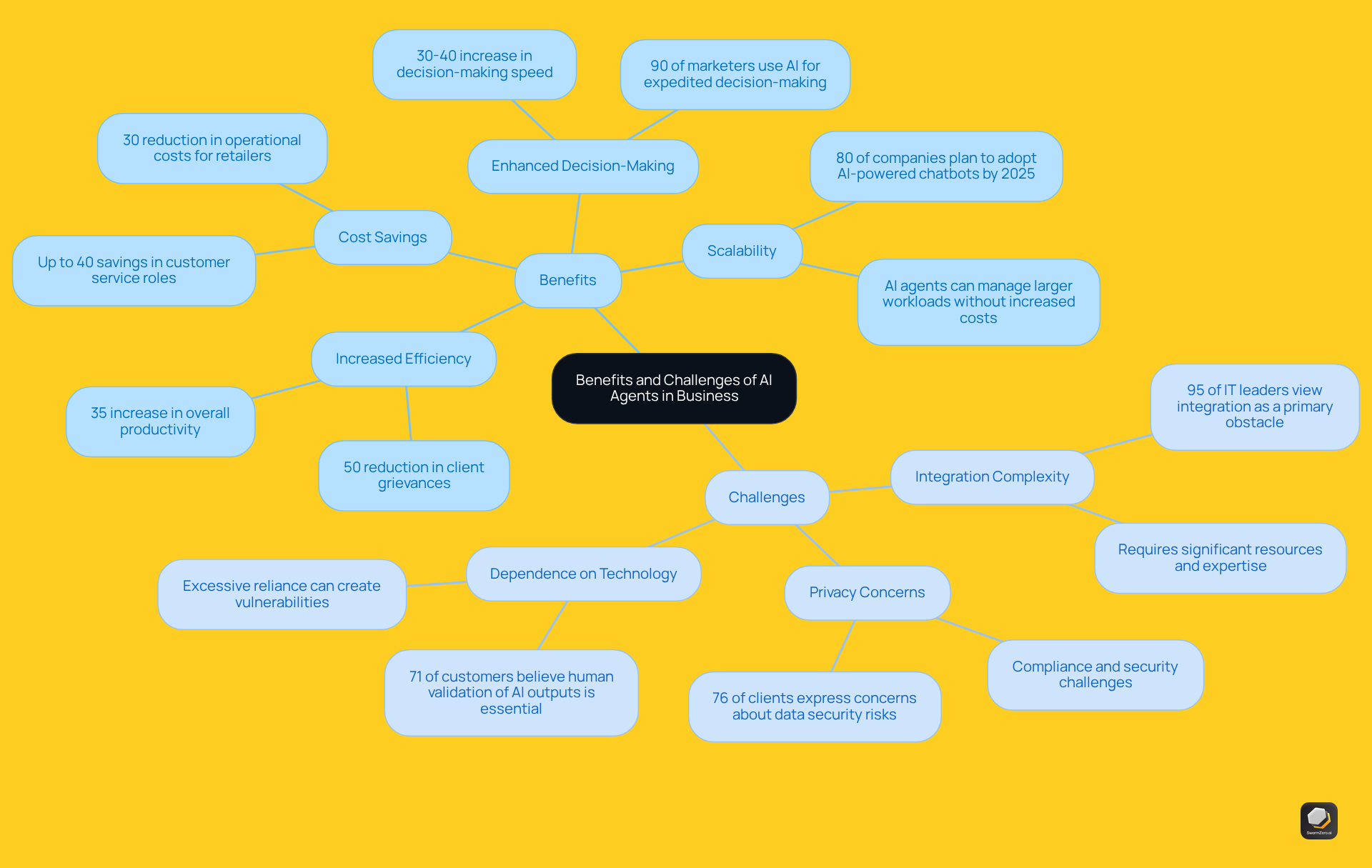Four Types of Agents in Artificial Intelligence: Key Characteristics and Uses
Explore the four types of agents in artificial intelligence and their key characteristics and uses.

Key Highlights:
- AI agents are independent systems that perform tasks autonomously, enhancing operational efficiency and decision-making.
- Core functions of AI agents include perception (data collection), decision-making (evaluating data), and action (executing tasks).
- The four types of AI agents are: Simple Reflex Agents, Model-Based Reflex Entities, Goal-Based Entities, and Learning Entities, each serving distinct purposes.
- Real-world examples show AI's impact, such as Walmart's 20% reduction in stockouts and JP Morgan Chase's $150 million annual savings from fraud detection.
- AI systems can lead to a 25% increase in operational efficiency and a 35% boost in overall productivity.
- Challenges in AI implementation include integration complexity, privacy concerns, and dependence on technology, with 95% of IT leaders citing integration as a major obstacle.
- Companies are increasingly adopting AI, with 82% planning to incorporate AI systems in decision-making processes in the near future.
Introduction
Artificial intelligence is revolutionising the way businesses operate, placing AI agents at the forefront of this transformation. These autonomous systems—capable of perceiving their environment, making decisions, and executing actions—are categorised into four distinct types, each with unique characteristics and applications. As organisations increasingly turn to AI to enhance efficiency and drive innovation, a critical question arises: how can businesses effectively leverage these diverse AI agents to navigate the complexities of modern operations while addressing the potential challenges that accompany their implementation?
Define AI Agents: Core Concepts and Functions
The four types of agents in artificial intelligence represent independent systems designed to perform tasks for users or other systems, operating under established rules or learned behaviours. This capability empowers them to make decisions and take actions autonomously, without the need for human intervention. The fundamental functions of AI agents encompass:
- Perception: Collecting data from their environment via sensors or inputs.
- Decision-Making: Evaluating data to identify the optimal course of action, which can involve the four types of agents in artificial intelligence.
- Action: Carrying out tasks based on the decisions made, which can vary from straightforward commands to intricate workflows, reflecting the four types of agents in artificial intelligence.
The four types of agents in artificial intelligence serve core functions that enable AI entities to automate repetitive tasks, significantly enhancing operational efficiency and supporting decision-making processes across diverse business contexts, including marketing and client service. For instance, AI systems can analyse customer interactions to develop personalised marketing strategies, leading to improved engagement and conversion rates.
Statistics indicate that organisations leveraging AI systems can realise up to a 25% increase in operational efficiency when these technologies align with strategic objectives. Real-world examples further illustrate this impact: Walmart has achieved a 20% reduction in stockouts through AI-driven inventory management, while JP Morgan Chase has reduced fraud-related losses by over $150 million annually by employing AI systems to scrutinise transactional data. These instances underscore the transformative potential of AI systems in driving efficiency and innovation within organisations. Additionally, SwarmZero offers a comprehensive AI marketplace that empowers businesses to create, monetize, and automate solutions. A notable application is the AI-powered web search tool utilising the Tavily API, which enhances search capabilities through AI-driven processing. This integration exemplifies how AI systems can streamline information retrieval and elevate user experience.

Explore the Four Types of AI Agents: Characteristics and Use Cases
AI agents can be categorised into four main types, each characterised by distinct features and applications:
-
Simple Reflex Agents: These agents operate based on predefined rules, responding directly to specific stimuli. They excel in straightforward tasks, such as automated client service responses.
- Use Case: A chatbot that provides immediate responses to commonly asked questions, enhancing customer satisfaction by minimising wait times. A study indicates that 67% of consumers feel frustrated when customer service cannot resolve their issues immediately, underscoring the significance of such representatives.
-
Model-Based Reflex Entities: These entities maintain an internal model of the environment, enabling informed decision-making based on past experiences and current states.
- Use Case: An AI system that refines marketing strategies by analysing previous campaign performance data, facilitating more effective targeting and resource allocation. This approach aligns with the growing trend where the share of companies running fully AI-led operations increased from 9% in 2023 to 16% in 2024.
-
Goal-Based Entities: These entities are crafted to accomplish specific objectives, assessing various options to identify the most efficient route.
- Use Case: An AI system that optimises supply chain logistics by evaluating different delivery routes, ultimately reducing expenses and delivery durations. A case study revealed that 69% of retailers utilising AI systems report significant revenue growth due to personalised shopping experiences, demonstrating the effectiveness of goal-oriented systems in real-world applications.
-
Learning Entities: These entities improve their performance over time by acquiring knowledge from interactions with their environment, adjusting strategies based on feedback.
- Use Case: A recommendation system that personalises content for users by analysing their browsing history and preferences, thereby increasing engagement and conversion rates. Adam Evans, SVP Product at Salesforce AI Platform, stated, "By adopting a user-first approach, every organisation can redefine their operations and stay ahead," emphasising the importance of learning systems in enhancing user experiences.
By understanding the four types of agents in artificial intelligence, companies can choose the most appropriate AI solutions to improve operational efficiency and effectiveness in their marketing and customer service strategies.

Understand How AI Agents Operate: Decision-Making and Learning Processes
AI agents operate through a systematic decision-making framework that encompasses several essential components:
- Data Collection: Agents gather information from their surroundings through various inputs, including user interactions, market trends, and operational metrics. This data serves as the foundation for informed decision-making.
- Analysis: The collected data undergoes analysis via sophisticated algorithms designed to uncover patterns, trends, and insights that guide subsequent actions.
- Decision-Making: Based on the analysis, representatives evaluate possible actions and select the most appropriate option to achieve their goals. This process involves assessing the potential outcomes of different choices to optimise results.
- Learning: Learning entities utilise feedback from their actions to enhance their decision-making abilities. By adapting their strategies based on successes and failures, they continuously improve their performance over time.
For instance, in a marketing context, a learning entity might evaluate the effectiveness of various advertising campaigns, adjusting its tactics according to which strategies yield the highest engagement rates. This continuous learning cycle enables AI systems to operate more effectively and efficiently, ultimately resulting in improved business outcomes.
Current trends indicate that AI systems are increasingly adept at processing multimodal data, thereby enhancing their analytical capabilities. As organisations adopt these technologies, the integration of AI systems into decision-making processes is expected to rise, with 82% of companies planning to incorporate AI systems within the next few years. This shift underscores the essential role of AI systems in enhancing operational efficiency and strategic decision-making across various sectors.
Evaluate the Benefits and Challenges of Implementing AI Agents in Business
Implementing AI agents in business offers a multitude of advantages, including:
- Increased Efficiency: AI agents automate repetitive tasks, enabling human resources to concentrate on strategic initiatives. This shift has led to a documented 35% increase in overall productivity across various sectors, while the implementation of AI systems has resulted in a 50% reduction in client grievances.
- Cost Savings: By reducing manual intervention, businesses can significantly decrease operational costs. Companies utilising AI systems have achieved up to 40% savings in customer service roles, demonstrating the financial impact of automation.
- Enhanced Decision-Making: AI systems deliver data-driven insights that facilitate improved decision-making processes. Organisations leveraging AI report a 30-40% increase in decision-making speed, highlighting the importance of timely information.
- Scalability: AI systems can manage larger workloads without a corresponding rise in costs, making them particularly beneficial for growing enterprises. This scalability is vital, as 80% of companies plan to adopt AI-powered chatbots for customer service by 2025.
However, businesses must also confront several challenges:
- Integration Complexity: The technical difficulties of incorporating AI agents into existing systems can be considerable, often necessitating significant resources and expertise. Approximately 95% of IT leaders view integration as a primary obstacle in effective AI implementation.
- Privacy Concerns: Implementing AI systems frequently involves handling sensitive information, leading to compliance and security challenges. With 76% of clients expressing concerns about data security risks, businesses must prioritise strong data governance.
- Dependence on Technology: An excessive reliance on AI systems can create vulnerabilities, particularly if technologies fail or yield inaccurate results. Balancing automation with human oversight is crucial to mitigate these risks, as 71% of customers believe it is essential for a human to validate AI outputs.
By thoughtfully weighing these benefits and challenges, businesses can develop a strategic approach to implementing the four types of agents in artificial intelligence, thereby maximising their advantages while navigating potential pitfalls.

Conclusion
Understanding the four types of agents in artificial intelligence is crucial for effectively harnessing their capabilities. These agents operate autonomously to perform tasks, significantly enhancing operational efficiency and decision-making across various sectors. By categorising AI agents into:
- Simple reflex
- Model-based reflex
- Goal-based
- Learning entities
businesses can pinpoint the most suitable solutions that align with their strategic objectives.
Throughout this discussion, key insights have emerged regarding the distinct characteristics and applications of each agent type. Simple reflex agents excel in straightforward tasks, model-based reflex entities leverage past experiences for informed decisions, goal-based entities concentrate on achieving specific objectives, and learning entities continuously improve through feedback. The transformative potential of these agents is evident in real-world applications, showcasing how AI can drive efficiency, cost savings, and enhanced decision-making.
As organisations increasingly adopt AI technologies, the importance of understanding these agents cannot be overstated. Embracing AI agents paves the way for improved operational performance, yet it is essential to navigate the challenges of integration and data privacy. By prioritising strategic implementation and ongoing evaluation, businesses can unlock the full potential of AI agents, ensuring they remain competitive in an ever-evolving technological landscape.
Frequently Asked Questions
What are AI agents and what do they do?
AI agents are independent systems designed to perform tasks for users or other systems, operating under established rules or learned behaviours. They can make decisions and take actions autonomously without human intervention.
What are the core functions of AI agents?
The core functions of AI agents include perception (collecting data from their environment), decision-making (evaluating data to identify the best course of action), and action (carrying out tasks based on decisions made).
How do AI agents enhance operational efficiency?
AI agents automate repetitive tasks, which significantly enhances operational efficiency and supports decision-making processes across various business contexts, such as marketing and client service.
Can you provide examples of AI's impact in real-world scenarios?
Yes, for instance, Walmart has achieved a 20% reduction in stockouts through AI-driven inventory management, and JP Morgan Chase has reduced fraud-related losses by over $150 million annually by using AI systems to analyse transactional data.
What statistics highlight the benefits of using AI systems in organisations?
Statistics indicate that organisations leveraging AI systems can realise up to a 25% increase in operational efficiency when these technologies align with strategic objectives.
What is SwarmZero and how does it relate to AI?
SwarmZero is an AI marketplace that allows businesses to create, monetise, and automate AI solutions. An example of its application is the AI-powered web search tool using the Tavily API, which enhances search capabilities through AI-driven processing.
How do AI systems contribute to personalised marketing strategies?
AI systems can analyse customer interactions to develop personalised marketing strategies, which can lead to improved engagement and conversion rates.
List of Sources
- Define AI Agents: Core Concepts and Functions
- AI Agents in 2025: Expectations vs. Reality | IBM (https://ibm.com/think/insights/ai-agents-2025-expectations-vs-reality)
- Microsoft Build 2025: The age of AI agents and building the open agentic web - The Official Microsoft Blog (https://blogs.microsoft.com/blog/2025/05/19/microsoft-build-2025-the-age-of-ai-agents-and-building-the-open-agentic-web)
- AI Breaking News: AI Agents – A New Era of Business Transformation | 10xMentorAI (https://10xmentor.ai/blog/ai-breaking-news-ai-agents-a-new-era-of-business-transformation)
- IBM Study: Businesses View AI Agents as Essential, Not Just Experimental (https://newsroom.ibm.com/2025-06-10-IBM-Study-Businesses-View-AI-Agents-as-Essential,-Not-Just-Experimental)
- Explore the Four Types of AI Agents: Characteristics and Use Cases
- 10 Real-World AI Agent Examples in 2025 (https://chatbase.co/blog/ai-agent-examples)
- AI Agent Statistics for 2025: Adoption, ROI, Performance & More (https://plivo.com/blog/ai-agents-top-statistics)
- Top AI Agents Statistics for 2025 (https://salesforce.com/news/stories/ai-agents-statistics)
- 30+ Powerful AI Agents Statistics In 2025: Adoption & Insights (https://warmly.ai/p/blog/ai-agents-statistics)
- Real-world gen AI use cases from the world's leading organizations | Google Cloud Blog (https://cloud.google.com/transform/101-real-world-generative-ai-use-cases-from-industry-leaders)
- Understand How AI Agents Operate: Decision-Making and Learning Processes
- 30+ Powerful AI Agents Statistics In 2025: Adoption & Insights (https://warmly.ai/p/blog/ai-agents-statistics)
- Autonomous AI agent can support clinical decisions in oncology (https://medicalxpress.com/news/2025-06-autonomous-ai-agent-clinical-decisions.html)
- 15+ AI Agents Statistics You Need to Know in 2025 (https://azilen.com/blog/ai-agents-statistics)
- AI Agents Statistics: Usage And Market Insights (https://litslink.com/blog/ai-agent-statistics)
- IBM Study: Businesses View AI Agents as Essential, Not Just Experimental (https://newsroom.ibm.com/2025-06-10-IBM-Study-Businesses-View-AI-Agents-as-Essential,-Not-Just-Experimental)
- Evaluate the Benefits and Challenges of Implementing AI Agents in Business
- 30+ Powerful AI Agents Statistics In 2025: Adoption & Insights (https://warmly.ai/p/blog/ai-agents-statistics)
- AI Agent Statistics for 2025: Adoption, ROI, Performance & More (https://plivo.com/blog/ai-agents-top-statistics)
- 25+ AI Agent Statistics Mirroring the 2025 Market! (https://experro.com/blog/ai-agent-statistics)
- IBM Study: Businesses View AI Agents as Essential, Not Just Experimental (https://newsroom.ibm.com/2025-06-10-IBM-Study-Businesses-View-AI-Agents-as-Essential,-Not-Just-Experimental)
- 100+ AI Statistics Shaping Business in 2025 - Vena (https://venasolutions.com/blog/ai-statistics)




